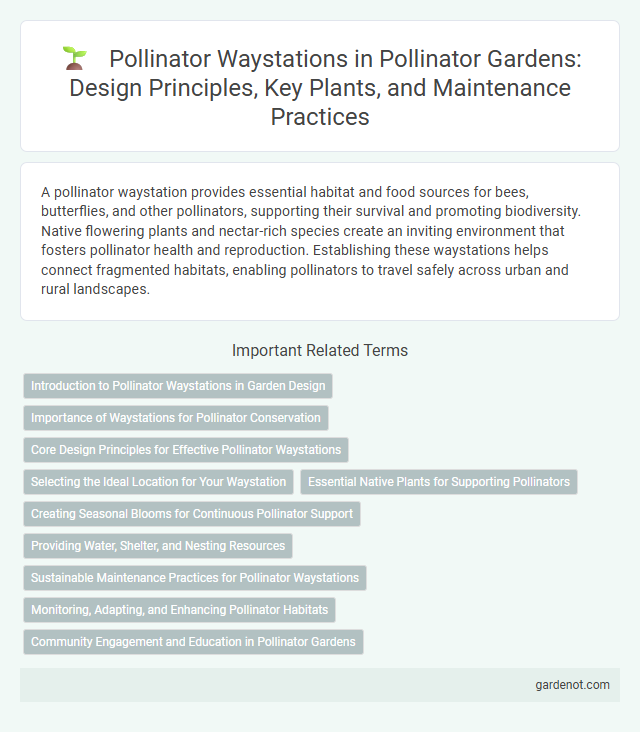A pollinator waystation provides essential habitat and food sources for bees, butterflies, and other pollinators, supporting their survival and promoting biodiversity. Native flowering plants and nectar-rich species create an inviting environment that fosters pollinator health and reproduction. Establishing these waystations helps connect fragmented habitats, enabling pollinators to travel safely across urban and rural landscapes.
Introduction to Pollinator Waystations in Garden Design
Pollinator waystations serve as critical habitats designed to support the health and diversity of pollinating insects such as bees, butterflies, and hummingbirds. These strategically placed garden sections incorporate native flowering plants that provide continuous nectar and pollen sources throughout the growing season. Integrating pollinator waystations into garden design enhances biodiversity, promotes ecosystem balance, and supports agricultural productivity by facilitating effective pollination.
Importance of Waystations for Pollinator Conservation
Pollinator waystations provide critical habitats that support the survival and reproduction of bees, butterflies, and other pollinating insects by offering diverse nectar sources and nesting sites. These strategically placed gardens enhance pollinator movement across fragmented landscapes, boosting biodiversity and crop pollination efficiency. Conserving pollinators through waystations contributes significantly to ecosystem health and agricultural productivity.
Core Design Principles for Effective Pollinator Waystations
Effective pollinator waystations prioritize native plant diversity to support a wide range of pollinators, including bees, butterflies, and hummingbirds. Incorporating continuous bloom periods ensures food availability throughout the growing season, while providing shelter in the form of nesting sites and protective cover promotes pollinator health and reproduction. Strategic placement near existing habitats and minimizing pesticide use further enhance the ecological value and sustainability of pollinator waystations.
Selecting the Ideal Location for Your Waystation
Choosing the ideal location for a pollinator waystation involves selecting a sunny spot that receives at least six hours of direct sunlight daily, which is essential for attracting a diverse range of pollinators such as bees, butterflies, and hummingbirds. The site should have protection from strong winds and be close to water sources to support the hydration needs of pollinators. Incorporating native plants and ensuring soil quality can enhance habitat suitability, promoting pollinator health and local biodiversity.
Essential Native Plants for Supporting Pollinators
Essential native plants such as milkweed, coneflower, and goldenrod provide critical nectar and pollen sources for pollinator waystations, supporting diverse species like bees, butterflies, and hummingbirds. These plants thrive in local ecosystems, ensuring sustainability and promoting biodiversity within pollinator habitats. Incorporating a variety of native flowering plants maximizes seasonal bloom periods, offering continuous nourishment for pollinators throughout the growing season.
Creating Seasonal Blooms for Continuous Pollinator Support
Creating seasonal blooms in a pollinator waystation ensures continuous nectar and pollen availability, supporting diverse pollinator species throughout the year. Incorporating native plants with staggered flowering periods enhances habitat stability and promotes pollinator health. Strategic planting of early spring bulbs, summer perennials, and fall flowering shrubs maximizes foraging opportunities during critical pollination cycles.
Providing Water, Shelter, and Nesting Resources
Pollinator waystations enhance garden ecosystems by providing essential water sources, shelter, and nesting resources tailored to support bees, butterflies, and other pollinators. Incorporating shallow water dishes, dense shrubs, and native plant stems ensures a hospitable environment that encourages pollinator presence and biodiversity. These features collectively contribute to improved pollination efficiency and sustainable plant growth.
Sustainable Maintenance Practices for Pollinator Waystations
Sustainable maintenance practices for pollinator waystations include using native, drought-resistant plants to reduce water consumption and enhance habitat resilience. Avoiding chemical pesticides and fertilizers supports pollinator health and promotes biodiversity. Regular monitoring and adaptive management ensure the waystation meets ecological goals while conserving resources efficiently.
Monitoring, Adapting, and Enhancing Pollinator Habitats
Pollinator waystations are critical for monitoring pollinator populations through regular surveys and data collection, ensuring accurate assessment of species diversity and abundance. Adaptation strategies involve modifying plant selections and habitat features to respond to environmental changes and emerging threats like disease or climate shifts. Enhancing pollinator habitats includes planting native flowering plants with staggered bloom times and creating nesting sites to support various pollinator species year-round.
Community Engagement and Education in Pollinator Gardens
Pollinator waystations serve as vital hubs for community engagement and education by providing accessible spaces that showcase native plants supporting bees, butterflies, and other pollinators. These gardens foster environmental stewardship through workshops, guided tours, and citizen science initiatives, empowering local residents to contribute to pollinator conservation. Educational signage and hands-on activities enhance public awareness about the importance of pollinators in ecosystem health and food production.
Pollinator waystation Infographic

 gardenot.com
gardenot.com